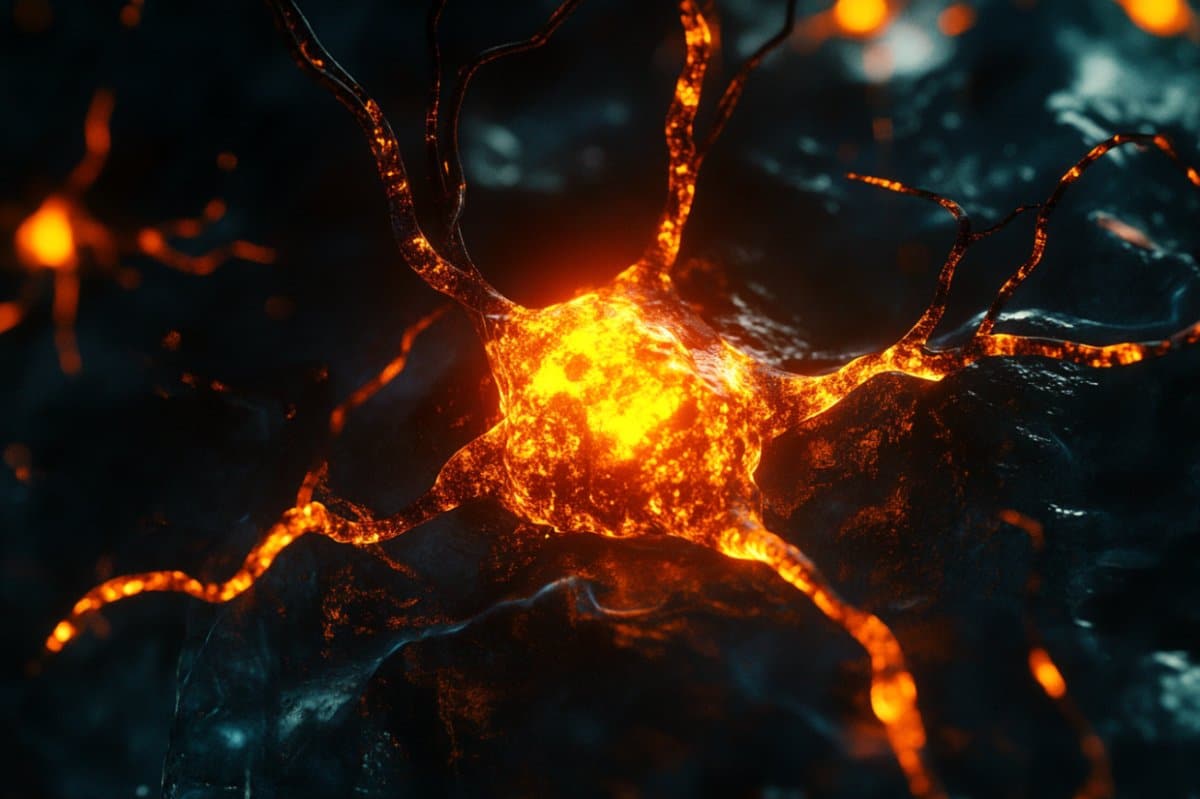Summary: Astrocytes, once thought to be mere support cells, are now shown to play a leading role in regulating behavior by modulating neuronal activity through slow biochemical circuits.
In zebrafish, researchers discovered that astrocytes respond to norepinephrine by releasing ATP, which is then broken down into adenosine, an important neuromodulator that signals neurons to stop swimming when progress is futile. Unlike the rapid signaling between neurons via neurotransmitters, this astrocyte-driven pathway unfolds over seconds to minutes, allowing for more flexible behavioral control.
Key Facts:
- Biochemical Circuit: Astrocytes release ATP, which becomes adenosine to modulate neurons.
- Slower Timescale: This signaling operates over seconds to minutes, unlike fast neuron-to-neuron communication.
- Therapeutic Potential: Targeting astrocyte pathways may open doors to treating psychiatric conditions.
Source: HHMI
Once thought to play a supporting function in the brain, new research shows non-neuronal astroglial cells perform a leading role in regulating the activity of neurons and their connections.
In 2019, Janelia researchers uncovered the critical role of glial cells called radial astrocytes in controlling an important “giving up” behavior in zebrafish.
They found astrocytes act as a counter, telling a fish to stop swimming when it isn’t getting anywhere – a behavior crucial for survival. But scientists didn’t know how the astrocytes communicated with neurons to control this action.

Researchers from Janelia and Harvard have now deciphered this conversation, revealing how astrocytes trigger a biochemical circuit that regulates neuronal activity and causes the fish to stop swimming.
While neurotransmitters enable fast communication between individual neurons that lasts milliseconds, neuromodulators like the circuit uncovered in the new work act on populations of neurons to tune neuronal signals over timescales that are more than a thousand times slower, enabling flexible behavior on a timescale of seconds to minutes.
The new work helps to uncover how such neuromodulators reach neurons and unveils a significant role for astroglia in neuromodulation. It also highlights the importance of including information about non-neuronal cells in research into how the brain works.
“I think the prevailing view is that a lot of the computations that are important for behavior come out of the patterns of connectivity between neurons,” says Alex Chen, a joint PhD student in the Ahrens Lab at Janelia and the Engert Lab at Harvard, who led the new research.
“This work shows that we have to understand biochemical computations and other forms of non-neuronal information and combine it with information about the connections between neurons to really understand what the brain is doing.”
Understanding how neuromodulators flow from astrocytes to neurons could also be important for treating psychiatric conditions, says Janelia Senior Group Leader Misha Ahrens, a senior author on the new research.
“Including these pathways more frequently in studies of psychiatric conditions makes a lot of sense,” Ahrens says.
“Knowing that a lot of the neuromodulation underlying brain function and dysfunction flows through astrocytes supports considering this new cell group as a potential therapeutic target.”
Uncovering the conversation
The new work builds on the previous research from 2019, also led by the Ahrens Lab, which uncovered the role of radial astrocytes in the “giving up” behavior. That research found that as the fish realizes it isn’t getting anywhere, it swims harder, and astroglia activity ramps up. When astroglia activity reaches a threshold, the cells signal neurons in the fish to stop swimming.
The team discovered that neurons signal astroglia to ramp up their activity by releasing a neurotransmitter called norepinephrine, which triggers the astroglia to accumulate internal calcium. But they did not know how the astrocytes communicated back to neurons to cause the fish to stop swimming.
In the new research, the team used a variety of sensors to figure out what molecules the astrocytes released when they were activated. They found that when calcium was elevated in astrocytes, ATP was released into the extracellular space between cells. Further, they showed that astrocytes, not neurons, released this ATP.
While ATP is widely known to be an energy-carrying molecule that fuels nearly all processes inside cells, it can also act as a signaling molecule on neurons through different types of receptors. However, when the researchers blocked these ATP receptors, they didn’t see any change in the zebrafish’s behavior.
This suggested that the ATP released from the astroglia was not acting directly on the neurons but was instead broken down. Previous research showed that when ATP is released extracellularly, enzymes convert it into adenosine – one of the components of ATP and a known neuromodulator in the brain.
The researchers found that when they blocked adenosine receptors on neurons, the giving up behavior was suppressed. That indicated that the extracellular pathway breaks down ATP into adenosine, which activates receptors on neurons that cause the fish to give up and stop swimming.
“It was surprising to me because it seems like such an indirect pathway,” Chen says. “First of all, a non-neuronal cell is involved and then, second of all, there’s this biochemical circuit instead of some sort of neuronal circuit that implements this behavior.”
The researchers think this type of biochemical circuit allows for modulation to happen on a slower time scale, compared to the very fast time scales of neural circuits. The researchers also speculate that the enzymes that break down ATP could play an important role in signal transmission – potentially another target for therapeutics.
In addition, companion research led by researchers at Washington University in St. Louis shows that neuromodulation by norepinephrine in the hippocampus in mice also flows through astrocytes to influence communication between neurons.
A related pathway has been identified in flies, and recently published work has implicated a similar pathway in depressive-like behaviors in mice.
A recent perspective by HHMI Investigator Cagla Eroglu also discusses these new findings.
These complementary studies raise the possibility that this pathway could potentially be at work in human brains and play an important role in brain function in both health and disease.
“This pathway seems to be conserved across flies and fish and mammals, so it might be an evolutionary ancient circuit motif,” Chen says.
About this neuroscience research news
Author: Nanci Bompey
Source: HHMI
Contact: Nanci Bompey – HHMI
Image: The image is credited to Neuroscience News
Original Research: Closed access.
“Norepinephrine changes behavioral state through astroglial purinergic signaling” by Alex Chen et al. Science
Abstract
Norepinephrine changes behavioral state through astroglial purinergic signaling
Both neurons and glia communicate through diffusible neuromodulators; however, how neuron-glial interactions in such neuromodulatory networks influence circuit computation and behavior is unclear.
During futility-induced behavioral transitions in the larval zebrafish, the neuromodulator norepinephrine (NE) drives fast excitation and delayed inhibition of behavior and circuit activity. We found that astroglial purinergic signaling implements the inhibitory arm of this motif.
In larval zebrafish, NE triggers astroglial release of adenosine triphosphate (ATP), extracellular conversion of ATP into adenosine, and behavioral suppression through activation of hindbrain neuronal adenosine receptors.
Our results suggest a computational and behavioral role for an evolutionarily conserved astroglial purinergic signaling axis in NE-mediated behavioral and brain state transitions and position astroglia as important effectors in neuromodulatory signaling.






